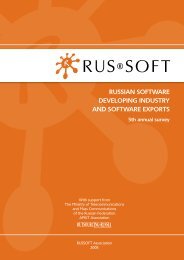russian software developing industry and software exports
russian software developing industry and software exports
russian software developing industry and software exports
Create successful ePaper yourself
Turn your PDF publications into a flip-book with our unique Google optimized e-Paper software.
Chapter 7.<br />
Technologies<br />
The results of the 2009 survey show that<br />
companies have considerably reduced the number<br />
of technologies <strong>and</strong> solutions used for <strong>software</strong><br />
development (operating systems, programming<br />
languages <strong>and</strong> tools <strong>and</strong> DBMS). For example, in<br />
the past any company used more than 3 operating<br />
systems on average (in 2008, this figure was 3.6).<br />
Moreover, the indicators remained the same from<br />
year to year without major fluctuations. In 2009, this<br />
indicator dropped to 2.3.<br />
The main reason of the reduced number<br />
of platforms used is evidently the crisis. The last survey<br />
was conducted in Q1 2009 right during the most<br />
difficult months, when there were neither new orders<br />
nor any certainty about the future, <strong>and</strong> outsourcing<br />
<strong>and</strong> product companies had to optimize the number<br />
of their employees. Otherwise stated, the staff was<br />
reduced <strong>and</strong> certain areas of technology development<br />
were closed. Gradually excessive competencies <strong>and</strong><br />
reserve of staff required at the stage of the boosting<br />
growth in order to quickly launch new projects were<br />
also cut down.<br />
Simultaneously with the «staff optimization»<br />
there were reduced license fees for OS, DBMS <strong>and</strong><br />
programming tools that either dismissed employees<br />
worked with or that were not used at full capacity,<br />
but were maintained for marketing purposes awaiting<br />
new orders.<br />
Such redundancy of skills <strong>and</strong> staff became<br />
unprofitable <strong>and</strong> unnecessary after the wave of crisis<br />
swept over the market.<br />
The second reason of the reduced number of tools<br />
<strong>and</strong> platforms used by respondents is a considerable<br />
increase in the number of companies answering the<br />
question about technologies. As compared to the<br />
2008 survey, the number of companies who answered<br />
the questions about platforms <strong>and</strong> tools grew from<br />
75 to 110. Practically all leading companies with a<br />
wide range of competencies actively participated in<br />
the poll in previous years, too. The increase in the<br />
number of respondents was mainly caused by new<br />
participants with a relatively small list of OS, DBMS<br />
<strong>and</strong> programming tools used by them.<br />
It is difficult to say how greatly the increase in<br />
the number of respondents influenced the ultimate<br />
results. However, it can me stated that in this case<br />
the role of the crisis was much greater. The list<br />
of technologies was mainly shortened by companies<br />
with a turnover less than 4 MUSD. It was this group<br />
that mostly influenced the frequency of records by<br />
each technology.<br />
According to the calculation methodology, any<br />
record of a single technology submitted by a major<br />
company with thous<strong>and</strong>s employees <strong>and</strong> a small firm<br />
with several people working have similar weight. The<br />
requirement to provide more detailed information<br />
on the number of employees using each <strong>and</strong> every<br />
technology would overload respondents <strong>and</strong> put at<br />
risk the representativeness of the survey.<br />
To more accurately reflect the real popularity of<br />
this or that system we separately provide data on the<br />
largest <strong>and</strong> the smallest companies. All other groups<br />
of companies get interim results.<br />
The larger the company, the higher its indicator of<br />
frequency of records for each technology. The same<br />
dependence exists concerning the share of export in<br />
total revenue. The bigger the export share, the higher<br />
the above indicator.<br />
Owing to the crisis we also managed to obtain<br />
additional information about OS, DBMS <strong>and</strong> tools<br />
used as a reserve (<strong>and</strong> vice versa – about technologies<br />
companies cannot ab<strong>and</strong>on despite the crisis).<br />
OPERATING SYSTEMS<br />
Due to the crisis Windows leadership has not<br />
shaken <strong>and</strong> its advantage over GNU Linux ranking<br />
second has even slightly increased. The lagging<br />
behind of other operating systems has intensified<br />
even more. An insignificantly smaller number of<br />
records against the previous year was registered for<br />
the 2 most popular families of OS (Windows <strong>and</strong><br />
GNU Linux) as well as Mainframe that came only last<br />
during the previous poll.<br />
The crisis has most negatively affected Novell<br />
Netware, DOS, Mac OS <strong>and</strong> Open/Free/NetBSD.<br />
However, this influence was reinforced by other<br />
factors, too. Most likely, the popularity of some<br />
systems already tended to decline.<br />
GNU Linux family still fails to approach Windows,<br />
despite some experts have been expecting this<br />
MS Windows<br />
GNU Linux<br />
family<br />
MS Windows<br />
Mobile<br />
Major operating systems<br />
17.1%<br />
26%<br />
Sun Solaris<br />
16.2%<br />
Symbian OS<br />
Mac OS<br />
HP-UX<br />
Open/Free/<br />
NetBSD<br />
DOS<br />
Novell<br />
Netware<br />
Mainframe<br />
0% 20% 40% 60% 80% 100%<br />
25%<br />
10.9%<br />
26%<br />
9%<br />
19%<br />
7.3%<br />
25%<br />
7.2%<br />
18%<br />
6.3%<br />
10%<br />
3.6%<br />
6.6%<br />
5.4%<br />
41%<br />
Poll 2008<br />
64%<br />
53.5%<br />
Poll 2009<br />
97%<br />
93.7%<br />
60








